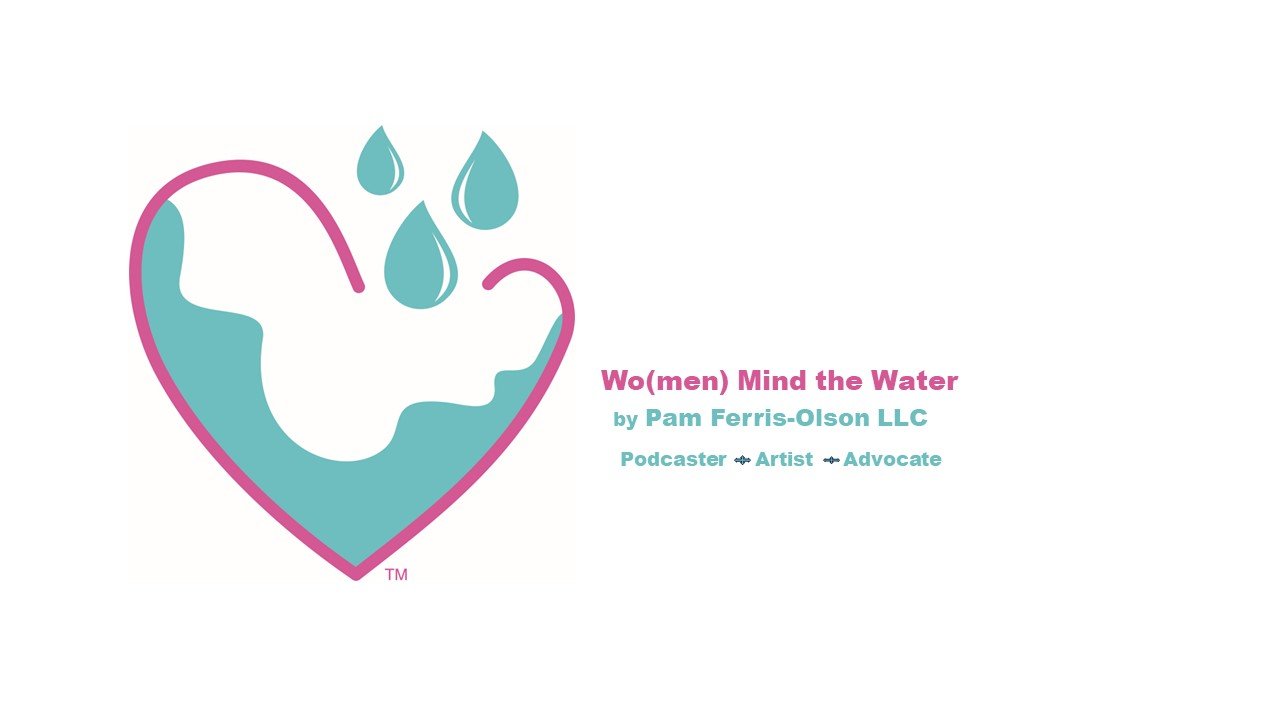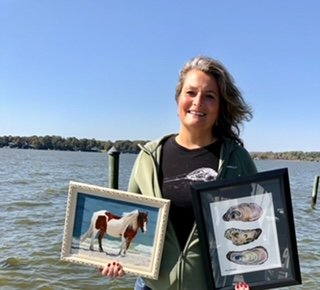Lisa Kozel Mangione
Lisa Kozel Mangione is a mixed media artist who is the definition of artivist. Lisa raises money for nonprofits by either donating her paintings directly to organizations or selling her work and then donating the proceeds. Lisa is currently using her art in service of a rural community in Harford County, Maryland. The land known as Mitchell Farm is under consideration for development as a freight distribution district. The possibility of the land being transformed from rural to industrial has spurred Lisa to action. She is concerned about the harm the development will cause on an area that used to be wetland. She is concerned that further industrialization of the area adds to the impacts on local waterways and ultimately Chesapeake Bay, the largest estuary in the United States. She wants people to know that even an average person can make a difference.
Blue de Gersigny
Blue de Gersigny is a plastic artist and designer. Blue lives in South Africa, a country quite literally at the southern tip of the African Continent. It is a country with nearly 3000 km or 1800 miles of coastline, bordering the Indian, South Atlantic and Antarctic oceans. From the beaches near her home, Blue collects colorful plastic and transforms it into eye-catching wearable art. Her intention is to make people aware of plastic debris and pick it up rather than walking by it.
Blue worked for many years as a textile designer until she realized she wanted to be an artist working with found objects. Originally Blue collected natural objects like bone, driftwood, and stone. Eventually, she was attracted to the colorful plastic that litters the beaches. Today her work is created almost entirely of plastic. The relentless of plastic waste rolling in on the tides inspires Blue to start her Plastics Are Forever website. Blue creates eye grabbing wearable art which she artfully displays on Instagram. After seeing one of her posts on Instagram, I knew I had to have her on this podcast.
Margaret Wertheim
Margaret Wertheim is an Australian-born science writer and artist who with her twin sister founded the Institute for Figuring. The Los-Angeles-based nonprofit explores the interrelationship of art, science, mathematics, and women’s handiwork. The Crochet Coral Reef is one of their projects and what we will focus our discussion on today. Margaret Wertheim holds degrees in mathematics and physics. Based on the mathematical discoveries of another mathematically-minded woman, Margaret and her twin sister Christine originated the Crochet Coral Reef project as a response to climate change. The Wertheims’ crocheted representations of coral has become a global collaboration with tens of thousands of people contributing their own pieces to citizen-generated art-installations.
Danielle Burnside
Danielle Burnside grew up in Michigan on a lake. At the time she was scared of anything that lived in the water. After she moved to Hawaii, she didn’t venture into the ocean for two years. It was divine intervention that a friend of hers who had been working on a manta ray tour point was leaving the job and offered her place to Danielle. Danielle had always wanted to see mantas but was scared of the dark water and got sea sick. She took Dramimine and went on an introductory tour. She fell in love with the experience and took the job. Her life changed when she went underwater.
Lisa Shaw
Lisa’s work demonstrates a woman deeply connected to water. She creates functional art that improves both the environment and people’s lives. Lisa is cofounder of the Scottish-based company Biomatrix Water. Their work involves the creation of floating islands or habitats that restore water quality, ecological habitat, and human connection to nature. Biomatrix Water does this with an interdisciplinary approach combining art, nature, and technology. Lisa explains how art and technology can work along with nature to heal urban eyesores and restore fresh water, estuarine, and even marine environment.
Colleen Flanigan
Colleen Flanigan describes herself as a socio-ecological artist. Her work is both functional and artistic. Colleen works at the intersection of art, science, technology, and the environment. Colleen has created metalwork in many forms including jewelry and puppets for motion pictures such as the stop-motion animation Coraline, a 2009 film directed by Henry Selick.. Colleen designed and built a sculptural frame for coral. This work promotes a healthy marine community, one that thrives in the presence of the coral growing on the frame. Her Living Sea Sculpture is on display in an underwater museum in Cozumel, Mexico. The video version of the podcast includes underwater footage of Colleen and her Living Sea Sculpture.
Kim Bernard
Kim Bernard is a full-time artist based in Maine who creates installations using upcycled trash. She works with communities to share the joy of making things using recycled materials. Kim has over 30 years of experience as a professional artist. She creates works with a range of materials from debris that washes ashore, bicycle inner tubes, plastic bags, even bowling balls. Kim has built a mobile recycling device. She uses her PopUpCycler to encourage communities to collect plastic trash. Together they shred the plastic and transform it into pieces that are assembled into a unique and meaningful installation for everyone to enjoy.
Erin Smith
Erin Smith is the CEO of Ocean Sole, a social enterprise that upcycles flip-flops found along the beaches and waterways of Kenya. Started a decade ago, Ocean Sole has created a unique space to talk about flip flop debris and a successful model for cleaning up ocean trash, and transforming the trash into colorful sculptures, high fashion clothes, and mattresses. Ocean Sole also provides the local community with sustainable employment, and educational opportunities.




















